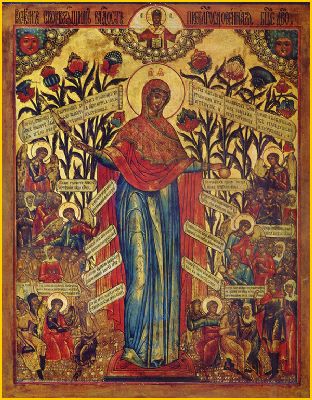|
|||
|---|---|---|---|
| This weekly bulletin insert complements the curriculum published by the Department of Christian Education of the Orthodox Church in America. This and many other Christian Education resources are available at http://dce.oca.org. | |||

The center of the icon called "Joy of All Who Sorrow" shows the Mother of God with her arms outstretched to the people who surround her. They are those who suffer with various illnesses, worries, and pain of the heart or the body. They reach toward her, asking her prayers and intercession. This is one of the icons in which the Theotokos is shown full length and standing, rather than holding her Son. He appears above her head, enthroned as the King of heaven and earth. In His left hand He holds the Book of the Gospels, and with His right He blesses the people—young, old, poor, rich—who are reaching out to His Mother. Flowers of Paradise, and angels on either side of the Theotokos, remind us that both the heavenly and earthly realms are part of the scene. Many stories of miracles and healings are associated with the icon. One of the best-known events took place in Saint Petersburg, Russia in 1888. Severe thunderstorms had struck the city and the surrounding area. A bolt of lightning struck the chapel in which the icon was housed. The bolt was so powerful that it set the interior walls on fire, burned most of the icons, and shattered the collection box. Only the icon of the Mother of God, the Joy of All Who Sorrow, was not ruined or even affected. An ear-shattering clap of thunder knocked the icon to the floor, and some copper coins which had been in the collection box became permanently fused to it. But the image on the icon was intact. The news that this single icon had been spared the destruction of the chapel and its contents spread through Saint Petersburg, and by evening crowds of people had gathered to venerate it. It was not long before people began coming from all over Russia, and many were healed of diseases and injuries as they prayed before it. It is easy to "put ourselves into" this icon, in which the Theotokos inclines her head slightly to one side, so as to listen attentively to us as we ask her to pray for us. One of the hymns associated with the icon expresses our request to her in this way: "Enlighten our hearts with devout purpose and raise your prayer to your Son for the salvation of our souls." She is the Mother who sees us, listens to us, understands with compassion, and willingly asks her Son Jesus Christ to have mercy. |
|||
